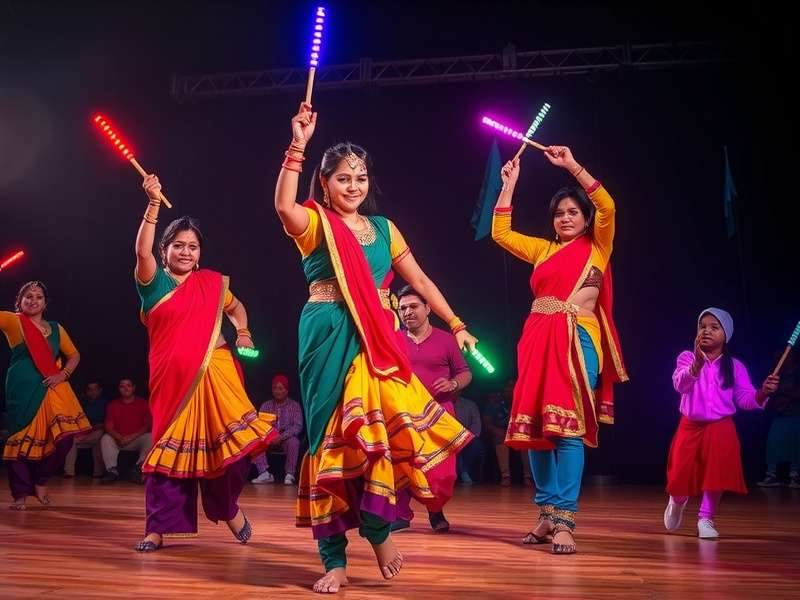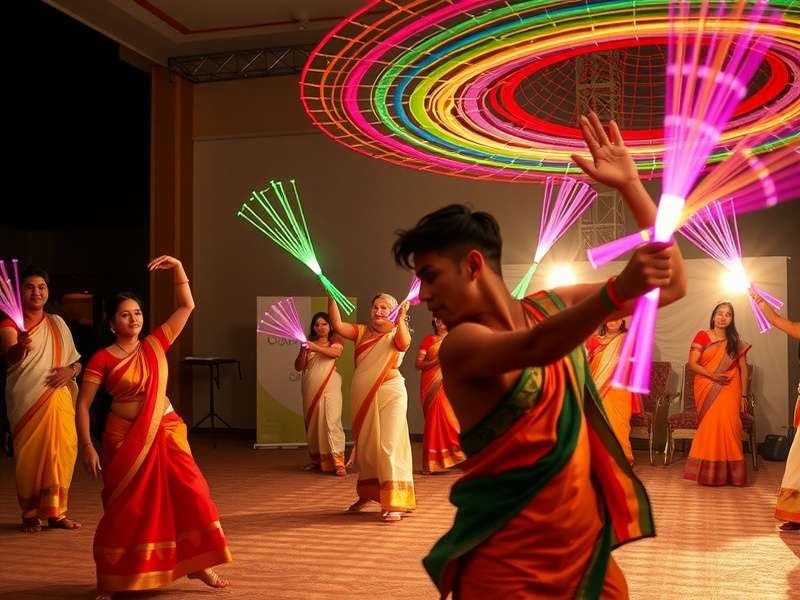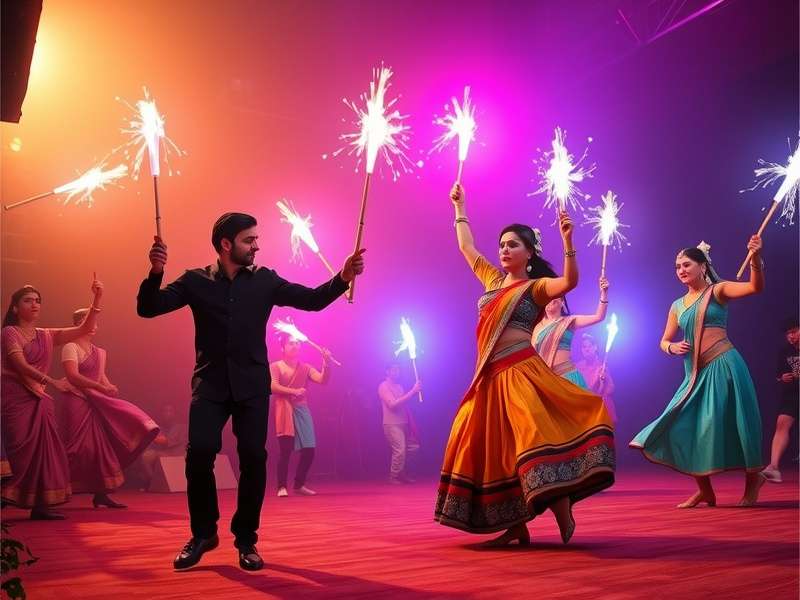Table of Contents
Overview of Dandiya Dance Dynamo
Dandiya Dance Dynamorepresents one of India's most vibrant and energetic traditional dance games, originating from the western state of Gujarat but now celebrated across the country and beyond. This dynamic performance art combines rhythmic movement, colorful costumes, and synchronized stick work to create a spectacular visual and auditory experience.
Key Insight:Unlike many traditional dances,Dandiya Dance Dynamofunctions as both an artistic performance and a competitive game, where participants engage in complex patterns while striking their sticks together in perfect timing.
The game typically involves pairs or groups of dancers moving in circular formations, each holding two decorated wooden sticks called 'dandiyas'. As the music accelerates, players must strike their partner's sticks in precise rhythmic patterns while executing intricate footwork. The combination of music, movement, and coordination creates an exhilarating experience that has madeDandiya Dance Dynamoa centerpiece of Indian festivals, particularly during Navratri celebrations.
What setsDandiya Dance Dynamoapart from similar dance forms is its competitive element. Participants can be eliminated for missing beats, dropping sticks, or failing to maintain the complex formations. This gamification aspect transforms the cultural tradition into an engaging activity that appeals to younger generations while preserving ancient artistic practices.
Dandiya Dance Dynamoserves as a powerful social connector, bringing communities together across generations. The game creates opportunities for interaction, friendship building, and cultural transmission in an enjoyable, participatory format.
The competitive nature ofDandiya Dance Dynamoadds excitement and engagement. Tournaments and championships have emerged, showcasing extraordinary skill and creativity while maintaining respect for traditional forms and rhythms.
Historical Origins & Evolution
The roots ofDandiya Dance Dynamoextend deep into Indian history, with references found in ancient texts and temple carvings dating back over two thousand years. Originally known as 'Dandiya Raas', this art form has evolved from a devotional practice into the dynamic game we recognize today asDandiya Dance Dynamo.

Historical evidence suggests that the earliest forms of stick dancing in India were practiced by tribal communities in Gujarat and Rajasthan as part of harvest celebrations and warrior training exercises. The rhythmic striking of sticks simulated combat movements while developing coordination, timing, and group synchronization - skills valuable both in battle and community life.
With the spread of devotional Hinduism, these folk traditions became incorporated into religious festivals, particularly those dedicated to Goddess Durga. The sticks came to symbolize the swords of the goddess, and the circular formations represented the cosmic dance of creation. This religious association helped preserve and spread the practice throughout Western India.
Historical Transition:The transformation from religious ritual to competitive game began in the mid-20th century as Indian communities migrated to urban centers. The need to engage younger generations in cultural practices led to the development of the more structured, rule-based format we now know asDandiya Dance Dynamo.
The formalization ofDandiya Dance Dynamoas a distinct game with standardized rules began in the 1970s, when cultural organizations sought to preserve traditional arts while making them appealing to contemporary audiences. This period saw the establishment of competitions, grading systems, and instructional programs that systematized the various regional variations into a more unified practice.
By the 1990s,Dandiya Dance Dynamohad gained popularity beyond its traditional regional boundaries, spreading throughout India and to diaspora communities worldwide. Bollywood films played a significant role in this expansion, featuring spectacular dandiya sequences that captured public imagination and introduced the art form to new audiences.
Essential Equipment & Tools
The equipment used inDandiya Dance Dynamocombines traditional craftsmanship with modern safety considerations. While the basic components remain simple, their design and decoration have evolved to enhance both performance and visual appeal.
Dandiya Sticks
The primary tools ofDandiya Dance Dynamoare pairs of colorful wooden sticks, typically 18-24 inches long. Traditionally made from bamboo or light wood, modern versions may incorporate synthetic materials for durability and weight optimization.
Traditional Attire
Participants typically wear traditional Indian clothing - ghagras (long skirts) and cholis (blouses) for women, and kurtas with turbans or caps for men. The vibrant colors and mirror work enhance the visual spectacle of the performance.
Musical Instruments
The rhythm is provided by traditional instruments including dhol (double-headed drum), harmonium, and manjira (cymbals). Modern adaptations may incorporate electronic music while maintaining traditional rhythmic patterns.
Modern innovations inDandiya Dance Dynamoequipment include glow-in-the-dark sticks for nighttime events, electronically synchronized sticks that light up on impact, and specialized footwear that facilitates the rapid footwork while reducing fatigue. These developments have made the game more accessible and visually spectacular, particularly in large-scale events and competitive settings.
Safety considerations have also influenced equipment design. Contemporary dandiya sticks often feature padded ends and lightweight construction to prevent injuries during vigorous play. This is particularly important in competitive versions ofDandiya Dance Dynamowhere the pace can be extremely fast and movements highly energetic.
Fundamental Dance Movements
The movement vocabulary ofDandiya Dance Dynamocombines precise footwork with coordinated arm motions and stick strikes. Mastering these fundamental patterns is essential for participation in the game, whether for recreational or competitive purposes.
Basic Stance & Posture
The foundational position inDandiya Dance Dynamoinvolves standing upright with feet shoulder-width apart, knees slightly bent for mobility. Dancers hold one stick in each hand, positioned at chest height with elbows bent at approximately 90-degree angles.
Essential Footwork Patterns
The most common step pattern involves a three-step movement forward followed by a three-step movement backward, synchronized with the musical rhythm. More advanced variations incorporate turns, cross-steps, and jumps that add complexity and visual interest to the performance.
Basic Stick Movements
The fundamental stick action involves striking your partner's sticks in rhythmic patterns. The most basic pattern alternates between striking your own sticks together and crossing to strike your partner's sticks, creating a continuous flow of movement and sound.
Formation Changes
An essential aspect ofDandiya Dance Dynamoinvolves transitioning between different formations, most commonly circles, lines, and partner pairs. These transitions must be executed smoothly while maintaining the rhythmic patterns.
Learning Progression:Beginners typically start with simple patterns at slow tempos, gradually increasing speed and complexity as they develop muscle memory and coordination. Most practitioners ofDandiya Dance Dynamorecommend at least 10-15 hours of practice to achieve basic proficiency.
Gameplay Mechanics & Rules
The transformation of traditional dandiya dance into the structured game ofDandiya Dance Dynamoinvolved establishing clear rules, scoring systems, and competitive formats. These mechanics balance respect for tradition with the engagement of gamification.

Basic Game Structure
A standard game ofDandiya Dance Dynamoinvolves multiple pairs or groups performing synchronized routines to traditional music. The performance space is typically circular, reflecting the traditional raas format, though rectangular competition spaces are also used in formal tournaments.
Games are divided into rounds with increasing tempo and complexity. The initial round establishes basic patterns at a moderate speed, with subsequent rounds introducing more challenging rhythms, formations, and movement sequences. Elimination occurs when participants make errors in timing, miss stick strikes, or fail to maintain proper formation.
Scoring System
In competitiveDandiya Dance Dynamo, scoring is typically based on three criteria: technical precision (40%), rhythmic accuracy (30%), and artistic expression (30%). Judges assess performances based on these weighted categories to determine winners in various competition classes.
Dandiya Dance Dynamocompetitions are typically organized by skill level (beginner, intermediate, advanced) and age group. This structure allows participants to compete against others of similar experience and ability, making the game accessible to all.
Official tournaments employ certified judges who evaluate synchronization, footwork precision, stick technique, costume authenticity, and overall performance energy. Detailed scoring rubrics ensure consistency and fairness across competitions.
Rule Variations
While standardized rules exist for formal competitions,Dandiya Dance Dynamoexhibits significant regional variation in informal settings. These local adaptations reflect cultural diversity while maintaining the core principles of rhythmic stick work and coordinated movement.
Some variations incorporate storytelling elements, with dancers enacting scenes from Hindu mythology through their movements and formations. Others emphasize athleticism, with acrobatic elements and extremely rapid sequences that test physical endurance as well as rhythmic precision.
Cultural & Social Significance
Dandiya Dance Dynamooccupies a unique position in Indian culture, serving simultaneously as religious observance, community celebration, and competitive sport. This multidimensional significance has ensured its continued relevance across generations and social contexts.
Community Building:The participatory nature ofDandiya Dance Dynamomakes it particularly effective at strengthening community bonds. The game requires cooperation, trust, and mutual awareness, fostering interpersonal connections across age, gender, and social boundaries.
During the nine nights of Navratri,Dandiya Dance Dynamobecomes a central community activity, with gatherings that may include hundreds or even thousands of participants. These events serve as important social occasions where community members reconnect, young people meet potential partners, and cultural traditions are passed to new generations.
The game also functions as a form of cultural preservation. As India modernizes and traditional practices face pressure from globalized entertainment,Dandiya Dance Dynamoprovides a dynamic vehicle for maintaining connection to heritage. Its gamified format makes traditional arts appealing to youth who might otherwise disregard them as outdated.
Religious & Spiritual Dimensions
Despite its evolution into a competitive game,Dandiya Dance Dynamoretains deep spiritual significance for many participants. The circular formations are understood to represent the cycle of life, death, and rebirth, while the rhythmic striking of sticks symbolizes the cosmic balance between opposing forces.
In its original religious context, the dance was performed as an offering to Goddess Durga, with the sticks representing her weapons in the battle against evil. This devotional aspect remains present even in secular competitions, where performances often begin with ritual prayers and offerings.
Educational Value
Beyond its cultural and religious functions,Dandiya Dance Dynamooffers significant educational benefits. The game develops physical coordination, rhythmic awareness, spatial reasoning, and teamwork skills. These attributes have led to its incorporation into some school physical education programs, particularly in Gujarat and Maharashtra.
The cognitive demands ofDandiya Dance Dynamoshould not be underestimated. Participants must simultaneously process auditory information (the music), execute precise physical movements, maintain spatial awareness of other dancers, and anticipate pattern changes. This multisensory engagement provides valuable neural stimulation across multiple domains.
Regional Variations Across India
WhileDandiya Dance Dynamohas its roots in Gujarat, the game has been adapted and transformed as it spread across India's diverse cultural landscape. These regional variations reflect local traditions, musical styles, and social structures while maintaining the core elements of rhythmic stick work.
Gujarati Style
The original form ofDandiya Dance Dynamoemphasizes graceful, flowing movements with particular attention to hand gestures and facial expressions. The footwork tends to be precise but not excessively vigorous, with emphasis on maintaining elegant posture throughout the performance.
Rajasthani Adaptation
In Rajasthan,Dandiya Dance Dynamoincorporates more vigorous movements and acrobatic elements, reflecting the region's warrior traditions. The tempo is generally faster, with more complex stick patterns that require greater physical endurance.
Maharashtrian Interpretation
The Maharashtra version ofDandiya Dance Dynamoshows influence from Lavani dance traditions, with more pronounced hip movements and playful interactions between partners. The formations tend to be more fluid, with frequent transitions between circles, lines, and other patterns.
South Indian Fusion
In states like Karnataka and Tamil Nadu,Dandiya Dance Dynamohas incorporated elements from local dance forms like Bharatanatyam, particularly in hand gestures (mudras) and facial expressions. The musical accompaniment may feature Carnatic rhythms alongside traditional Gujarati patterns.
These regional variations demonstrate the adaptability ofDandiya Dance Dynamowhile maintaining its essential character. Rather than diluting the tradition, this diversity has enriched the practice, creating a vibrant tapestry of interpretations that reflect India's cultural pluralism.
In recent years, there has been growing interest in creating standardized forms ofDandiya Dance Dynamofor national competitions while still preserving regional distinctive. This balanced approach honors local traditions while facilitating broader participation and comparison across geographic boundaries.
Modern Evolution & Global Reach
The contemporary landscape ofDandiya Dance Dynamoreflects both technological innovation and globalization. What was once a regional folk tradition has transformed into an international phenomenon with professional competitions, digital learning platforms, and fusion styles that blend traditional elements with contemporary influences.

Technological Innovations
Modern technology has significantly impacted howDandiya Dance Dynamois practiced, taught, and experienced. LED-equipped sticks that light up on impact have created spectacular visual effects for large-scale performances. Mobile applications provide rhythm training, step tutorials, and virtual competitions that make the game accessible to isolated practitioners.
Social media platforms have created global communities ofDandiya Dance Dynamoenthusiasts who share videos, techniques, and organizational information. This digital connectivity has accelerated the exchange of ideas and innovations while helping to maintain cultural connections for diaspora communities.
Global Expansion:The international spread ofDandiya Dance Dynamoreflects broader patterns of Indian diaspora cultural maintenance. Major cities with significant Indian populations now host annual competitions that attract participants from multiple countries, creating transnational networks of practitioners.
Fusion & Contemporary Adaptations
AsDandiya Dance Dynamohas globalized, it has inevitably incorporated elements from other dance traditions and popular culture. Fusion styles blend traditional stick work with hip-hop, ballet, and contemporary dance movements, creating hybrid forms that appeal to diverse audiences.
These innovations have sometimes generated controversy among traditionalists who worry about cultural dilution. However, most practitioners view fusion as a natural evolution that keeps the tradition vibrant and relevant. The core principles ofDandiya Dance Dynamo- rhythmic precision, coordinated movement, and community participation - remain intact even in experimental formats.
Professionalization & Economic Impact
The growing popularity ofDandiya Dance Dynamohas created economic opportunities ranging from professional performers and instructors to costume designers, stick manufacturers, and event organizers. Major competitions offer substantial prize money, supporting the development of career pathways for exceptional talent.
This professionalization has raised standards of performance while creating new challenges around commercialization and cultural authenticity. The community continues to negotiate the balance between preserving traditional values and embracing the opportunities presented by growing mainstream interest inDandiya Dance Dynamo.
Looking forward, the evolution ofDandiya Dance Dynamoseems likely to continue along multiple trajectories - preservation of traditional forms, development of competitive structures, exploration of fusion styles, and expansion of digital accessibility. This multidimensional growth reflects the game's unique ability to simultaneously honor heritage while embracing innovation.
